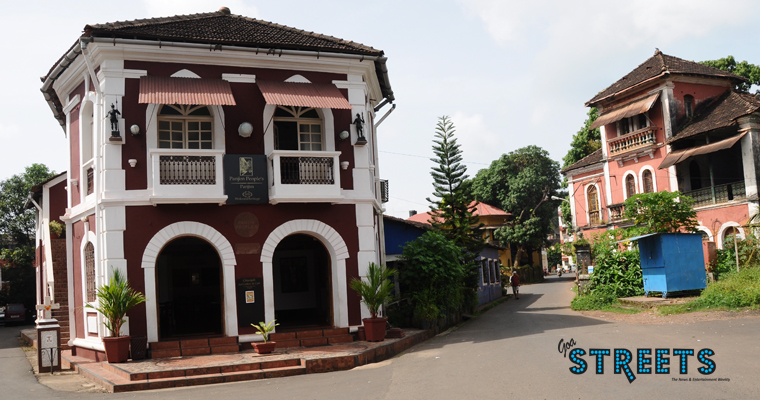Panjim’s beauty is self evident, pharmacy but to find its quirky surprises, you’ll have to scratch beneath the surface.
Did you know, cost for instance, that a crucifix with an open-eyed Jesus at the St. Sebastian Chapel was meant to intimidate natives during the Inquisition? Or that one of the city’s top gardens was named after a Portuguese Jewish physician who was a pioneer in tropical medicine? Or that it was Asia’s first city to have a medical college, and the first in India to install a sewer and planned grid system?
Despite those grids, the most beautiful part of Panjim is also the one which is most unplanned, says noted city historian and author Vasco Pinho, as he leads a motley group of about 20 heritage enthusiasts around the city he has loved all his life.
Vasco, in his late sixties, goes on and on about the city around which Goa has evolved for several hundred years – from a fishermen’s swamp to a fine exponent of Indo-Portuguese architecture and the state’s undisputed artistic, cultural and financial centre.
To be sure, Panjim is not without its major faults. Out-of-control traffic, insufficient parking, inadequate public transport, spotty garbage disposal, destruction of historic sites to make room for modern eye sores, to name a few.
Still, it is arguably one of the most beautiful and well planned cities in the country.
Vasco explained that Fontainhas, the Portuguese word for fountains, derived its name from the many natural springs which once dotted the area.
“What makes Fontainhas so special is that it was not planned and by and large there are no foot paths,” says Vasco as we walk through the Latin quarter, covering the colourful Mediterranean-style by-lanes of the Fontainhas and Mala neighbourhoods.
As we stop in front of the St. Sebastian Chapel, built in 1887, I gaze at a rare image of Jesus on a life-size crucifix.
Unlike just about every other crucifix on the planet, his eyes are open.
It turns out the statue once hung in the Palace of the Inquisition, which before its destruction by the Portuguese stood in the Old Goa Church complex. The eyes are open for a reason: To put fear into the mind of local natives who were interrogated – and sometimes tortured and killed – by the Inquisitors.
Damodar Ghanekar is a Konkani writer, Panjimphile and friend of Vasco’s who went along for the walk, sometimes gently second guessing his friend. He points out the top of a staircase at Altinho Hill that he says exemplifies another extraordinary aspect of the Goan capital: The effortless coexistence of Muslims, Christians and Hindus.
From the hill’s peak, he explains you can “see a scenic view of the the Jama Masjid, Panjim Church and the Maruti Mandir and that is communal harmony.”
Sometimes seeing Panjim’s beauty requires a bit of imagination, as is the case with a stunning staircase leading to what was once a Portuguese-run school called the Liceu and is now the Bombay Bench High Court.
“Since the High Court Judges no longer use it, this is the state and no one has cleaned it,” he says, describing the decrepit state of the staircase built in the 1880s.
Vasco himself once attended the now defunct Liceu, which “only the cream of the society could afford.”
“But they never taught us about monsoons, stupid people,” he quips, lamenting the European-centric curriculum that treated Goa as an afterthought.
Nostalgia takes hold of Vasco and Damodar as they look at a street full of parked cars in Fontainhas and recall how they used to play goodha – or marbles – as children on the same road.
As we stood before the magnificent Church of the Immaculate Conception, in Vasco’s words, the “most photographed place in the whole of Goa,” the expert told us about the facets which have gone missing from the grand 16th century church, including Goa’s only clock tower, which collapsed in 1952.
As we moved forward, Vasco explained how the Jardim Garcia de Orta, a lovingly maintained garden in a city with its own unique history of anti-Semitism, got its name from a Jew.
“It was named after a Jewish physician and botanist who came to India to study ancient medicinal practices”.
The sense of nostalgia so permeated our walk – dubbed Cholta Cholta, or While we Walk, by the organizers – that we were not spared the rigors of history even when we stopped for tea and pao bhaji at Café Tato.
“This is the second oldest tea shop in Panaji. The first was Café Central,” said organizer Pritha Sardessai, as we sipped tea at the 99-year-old joint. These regular walks, Pritha says, can be one of the many faces of tourism for Panjim.
“It’s time this starts appearing as our main focus as against casinos, beach parties, etc,” she insists.
A few hundred metres away eager gamblers queue up to hitch a boat ride to one of the six offshore casinos in the Mandovi river. Yes, the same river used by Afonso de Albuquerque and his fleet to invade Goa 502 years ago.




